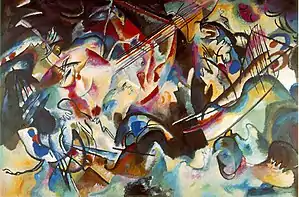Composition VI
Composition VI is a 1913 oil painting on canvas by the Russian artist Wassily Kandinsky, now in the Hermitage Museum.

The result of 24 studies, it took the painter eight months to complete the painting. He wanted to depict a flood, a baptism and the theme of destruction and rebirth. His assistant, Gabriele Münter - with whom he had a professional and personal relationship between 1902 and 1916[1] - advised him to break free from the initial outline and think about the German word 'Überflut' (flood) and the acoustic sensations it suggested to him. Kandinsky finished the painting within three days of that suggestion, intoning the word 'uberflut' for those whole three days.[2][3]
Composition VI was the artist's main entry for the Erster Deutschen Herbstsalon (First German Autumn Salon), organized in 1913 in Berlin by Herwarth Walden, alongside painters such as August Macke and Franz Marc.[4]
References
- Gaze, Delia (1997). Dictionary of women artists. Volume 2. Chicago: Fitzroy Dearborn.
- http://www.wikiart.org/en/wassily-kandinsky/composition-vi-1913
- (in Portuguese) Vários (1995). Grandes Pintores do Século XX. Mondrian 1872-1944. 3. Madrid: Globus Comunicación. ISBN 84-8223-005-0
- (in Portuguese) Düchting, Hajo (2005). Wassily Kandinsky - A Revolução da Pintura. Alemanha: Paisagem. 96 páginas. ISBN 3-8228-4373-3